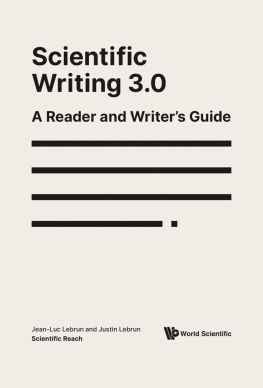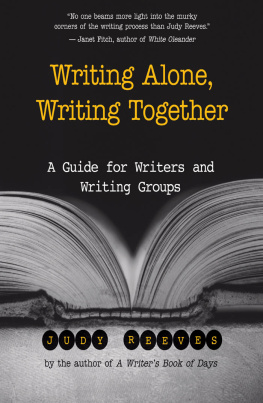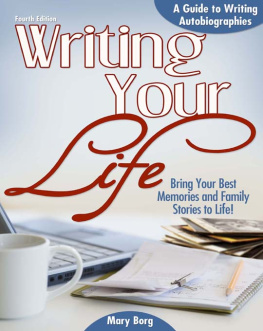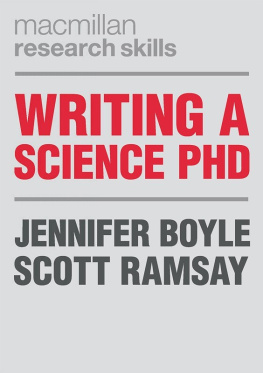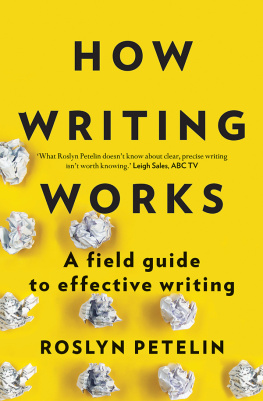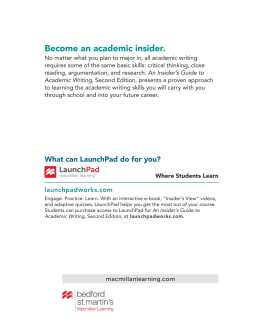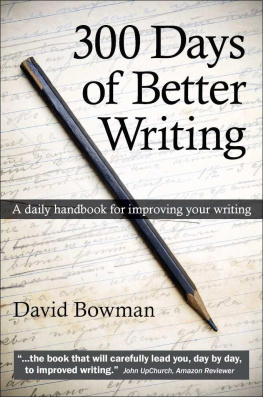Contents
Pagebreaks of the print version

Scientific Writing 3.0
A Reader and Writers Guide
Scientific Writing 3.0
A Reader and Writers Guide
Jean-Luc Lebrun and Justin Lebrun
Scientific Reach

Published by
World Scientific Publishing Co. Pte. Ltd.
5 Toh Tuck Link, Singapore 596224
USA office: 27 Warren Street, Suite 401-402, Hackensack, NJ 07601
UK office: 57 Shelton Street, Covent Garden, London WC2H 9HE
British Library Cataloguing-in-Publication Data
A catalogue record for this book is available from the British Library.
SCIENTIFIC WRITING 3.0 A
Reader and Writers Guide
Copyright 2022 by World Scientific Publishing Co. Pte. Ltd.
All rights reserved. This book, or parts thereof, may not be reproduced in any form or by any means, electronic or mechanical, including photocopying, recording or any information storage and retrieval system now known or to be invented, without written permission from the publisher.
For photocopying of material in this volume, please pay a copying fee through the Copyright Clearance Center, Inc., 222 Rosewood Drive, Danvers, MA 01923, USA. In this case permission to photocopy is not required from the publisher.
ISBN 978-981-122-883-4 (hardcover)
ISBN 978-981-122-953-4 (paperback)
ISBN 978-981-122-884-1 (ebook for institutions)
ISBN 978-981-122-885-8 (ebook for individuals)
For any available supplementary material, please visit
https://www.worldscientific.com/worldscibooks/10.1142/12059#t=suppl
Typeset by Stallion Press
Email:
Printed in Singapore
Preface
You are a scientist. You have spent years educating yourself and improving your research skills. Years of perfecting new technologies and methodologies, years of data collection and organization, and years of adapting to new challenges. Every hour spent in the lab, at the library, or at home in front of your computer has broadened your knowledge and capacity in your field. With dedication, persistence, and occasional failure, you have discovered something new something unknown to the world. You have pushed the boundaries of science just a little, but you can justifiably say that you are among the worlds experts in your niche field possibly the sole expert. But what good is it to be the worlds sole expert? Alone, you are ill-equipped to shoulder the burden of scientific progress. So you uncap your pen (or pull out your keyboard) and start writing a letter (your paper) to other scientists.
Herein lies a problem. Writing the task in front of you is not research-based. You may feel intimidated. After all, you probably have not received specific training to face the many challenges of peer-to-peer communication through academic journals.
At this juncture, you have two options. The first path is the road most travelled: You do not consider you lack expertise in writing. After all, have you not already written hundreds of thousands of words over the course of your education? Have you not already published several theses at the bachelor, master, and Ph.D. level? And if you do lack expertise, do you not have an ocean of examples in front of you in hundreds of academic journals, papers that you can study and learn from or emulate? Or does it even matter whether you are a great writer? You chose to do science, not literature.
The second path is the road less traveled: You want to gain expertise in writing, become a better communicator to enhance your publication chances. It is the path that you, by picking up this book, are considering.
Would it surprise you if we told you that both paths lead to the same destination? One road winds back and forth, passing through metaphorical mists, moats, and brambles. It takes years to travel, and is littered with paper rejections and writing hardship. At its end, you may have mastered many aspects of writing, but at what personal cost? The other path is much shorter. It is a steep uphill climb for a few weeks, but from its summit, you can clearly see the brambles, the moats, and the mists and walk right past them.
This book is your roadmap to the top of the hill. Reading it and practicing the recommended techniques are the steep uphill climb. You will need to flex your intellectual muscles, not walk the talk, but walk the thought, put it in motion through our specially crafted exercises. You may even feel sore for a while. But that path is worth following.
You can choose to master many skills during your lifetime. Some will be helpful in highly specific situations (replacing a car tire), while others will find use in broader situations (swimming). But certain skills affect so many facets of your life that it would be almost negligent not to master them. Writing is one of them.
The book you are holding today is not the same roadmap we initially presented in the 2007 or 2011 editions. Todays book is Scientific Writing 3.0 the third chronicle of our constantly evolving research into the minds of readers and writers. It has been updated with new examples, new stories, and new discoveries. While the initial versions of the book focused on writing techniques, this new edition also discusses the writers attitude towards the audience, strategies for getting published, objective measures of readability, and the predominant scientific writing style, with its characteristics and pitfalls.
Youre on the right path now take the first step.
This isnt a hypothetical encouragement- weve heard this exact feedback from senior scientists who have expressed the regret of not having read this book earlier in their careers.
Contents
Part 1
The Reading Toolkit
This title probably conjures up the image of a schoolboys pencil-case containing a few chosen items designed to help reading: a pair of glasses for better readability of the footnotes and formulas, a bookmark to help with our failing memory, a bag of pekoe tea to boost our attention when it declines, a LED flashlight to continue reading in the dark when away from electricity. The reading toolkit I have in mind, however, is filled with resources of the invisible kind: time, memory, energy, attention, and motivation. A skillful writer uses this toolkit to minimize the time, memory, and energy needed for reading while keeping reader attention and motivation high.
Chapter 1
Writer vs. Reader, a Matter of Attitude
Allow me to begin this book by asking you a rather startling question: who are you? A reader or a writer?
Youre reading this book, so you must be a reader.
And youre reading this book so you must be a writer.
More precisely, you are both a reader and a writer scientist. You read papers published in academic journals to deepen your knowledge of the field, learn about recent advances or breakthroughs, or even borrow certain steps from an existing protocol. You may occasionally read out of curiosity, but you never read academic papers for fun. You are a reader with a purpose, a need to fulfil. As for being a writer scientist, you dont write papers for fun either. So why do you write?
Allow me to introduce you to the archetypal science writer, John.
John enjoys research. He would love for his work to be recognized and to lead his own team as a PI someday. More pressingly, his boss requires him to hit certain key performance indicators (KPI), including getting a number of papers published in high-tier journals each year. So John prepares his papers with the following idea in mind: Ive done the research. Now I need to write down what Ive done so that my work can be documented, officially recognized through citations, and help me hit my KPI.

